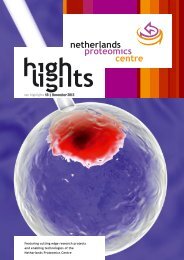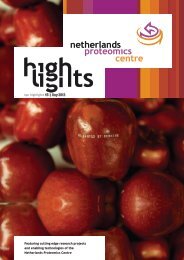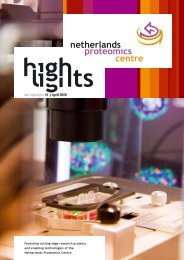NPC Valorisation Voucher - Netherlands Proteomics Centre
NPC Valorisation Voucher - Netherlands Proteomics Centre
NPC Valorisation Voucher - Netherlands Proteomics Centre
You also want an ePaper? Increase the reach of your titles
YUMPU automatically turns print PDFs into web optimized ePapers that Google loves.
What this research is about:Advanced tools for in depth research onleukaemia drug effectChronic myeloid leukaemia is characterised by an abnormalincrease in immature white blood cells and it is treated withthe first line drug Imatinib, also known as Gleevec. The drugsuppresses the cell growth and division by inhibiting theresponsible kinase (Bcr-Abl) enzyme that is continuouslyactive due to an acquired mutation. “There is a lot ofknowledge about the drug and how it works on this kinase inthe leukemic cells, but what happens afterwards in the cellis not completely clear,” says Arjen Scholten, assistant professorof the Biomolecular Mass Spectrometry & Protemicsgroup of Utrecht University. “This kinase enzyme bindsspecifically with the amino acid tyrosine and attaches aphosphate label to it. It was not easy till now to detect thisphosphate modified tyrosine using conventional methods,since only a small percentage of all phosphate modificationspresent in the cell are of this specific type.”In this article the authors describe a method that canscreen specifically for these modified tyrosine substratesin leukemic cells. “We show that this tool can give insightinto a whole protein network at the same time. We identifiedapproximately two hundred modified tyrosine proteins,some already known and many new ones,” Scholten says.He picked one of the newly found proteins to study in moredepth in order to demonstrate the potential of this discoverytool.Since patients develop resistance to Imatinib after a certainperiod, other targets in the field of the kinase activity couldbe alternative approaches to circumvent resistance. Scholtenexplains: “Our studied protein might be an interesting targetfor a new drug. But that is long term thinking and not reallyour expertise. We used leukemic cells as a model system togain new insights into how Imatinib influences related proteinsin the leukemic cells. This screening technique can beenormously valuable for understanding biological networks.”| 13<strong>NPC</strong> E2: Chemical Approaches to Proteome Biologyfluorescence. Over the last few years, these antibodies havealso been used for the enrichment of tyrosine phosphorylatedproteins followed by mass spectrometry analysis [2]. However,detection of the actual phosphotyrosine residue is then hamperedby the high presence of unmodified peptides derivedfrom the captured phosphotyrosine modified protein and itsco-purifying binding partners.More recently, the field successfully shifted to the peptidelevel for the immune affinity purification (IAP) of phosphotyrosinepeptides from samples as complex as whole cell lysatedigests [3-5]. Most notably, Rikova et al. applied such an approachto investigate tyrosine kinase signalling across 41 lungcancer cell lines and over 150 tumours [5]. The most importantdifference with the protein level immunoprecipitation isthat this approach allows the identification and localisationof the exact phosphotyrosine residue in the protein on everyidentified protein.Here we describe how we adopted the IAP method to introducea robust and simple procedure that allows the identificationof hundreds of tyrosine phosphorylated residueswithin only 6 hours of mass spectrometry analysis time.When coupled to labelling strategies such as iTRAQ, SILAC ordimethylation (used here), this technique is able to extractbiologically rich quantitative information on tyrosine phosphorylationdriven signalling in differential conditions.Leukaemia and Gleevec The fusion kinase Bcr-Abl is the majorcause and pathogenetic principle of chronic myeloid leukaemia(CML). Bcr-Abl results from a chromosomal translocationthat fuses the bcr and the abl genes, thereby generating aconstitutively active tyrosine kinase, which stimulates severalsignalling networks required for proliferation and survival.Bcr-Abl’s oncogenic properties comprise both a kinase and ascaffold protein. A number of Bcr-Abl interaction partners anddownstream effectors have been described, improving ourunderstanding of the signalling networks deranged in CML. The‘core-interactome of Bcr-Abl’ entails seven major interactionpartners: GRB2, Shc1, Crk-l, c-Cbl, p85, Sts-1, and SHIP2 [6](see Figure 2).The introduction of the Bcr-Abl tyrosine kinase inhibitor (TKI)Imatinib (Gleevec) has been a landmark in the treatment ofCML. However, the development of Imatinib resistance poseschallenges to the clinical management of CML, and althoughsecond generation TKIs can block many Imatinib resistantmutants, they are ineffective against the common T315Imutation. An alternative strategy is to circumvent Imatinib






